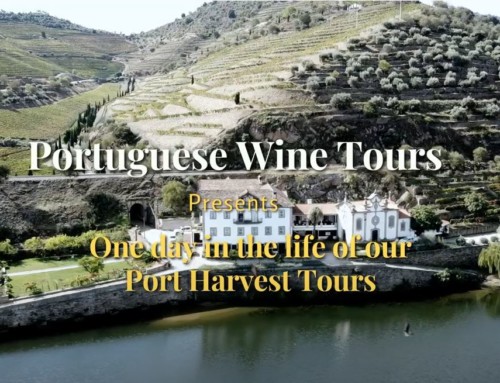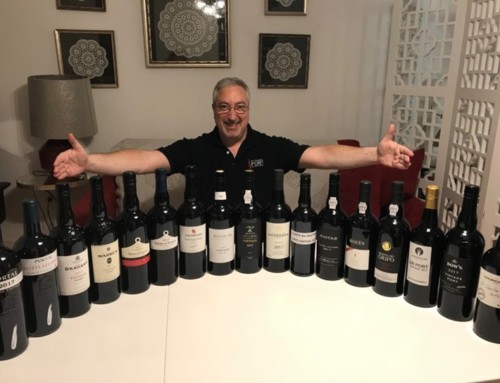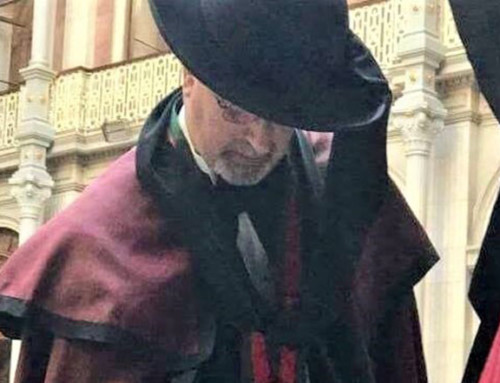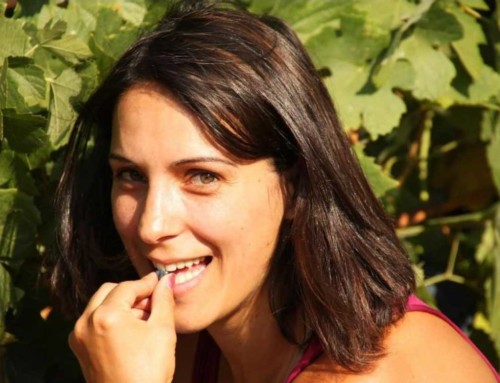Douro bound. It was Wednesday, the third week of February and our few days in Porto had been fruitful, but it was time to head up to the greatest wine region on earth. Given the small size of our group, a closeness was developing and several of us took turns playing chess together and we had what seemed like a quick ride up to wine country. We arrived in Pinhão and were dropped off at a riverside dock, while our driver left to deliver our luggage to our next vinous destination.
We'd planned to rendezvous with a recently renovated boat, an absolutely beautiful craft, about 50' in length with numerous cabins below and a great upper deck area too. We were most fortunate to have a warm, sunny day with temperatures in the mid-sixties. We sat at the captain's table and enjoyed well-chilled bottles of 2009 Crasto White DOC wine, refreshing and paired with a selection of delicious appetizers while heading lazily down river at a deliberately slow pace. Cameras were snapping photos with rapidity as we sailed past prominent properties in the heart of the Cima Corgo and enjoyed the great scenery and weather.
About an hour later we reached our destination and disembarked after thanking the effervescent crew. After a leisurely walk around the interesting waterfront landscape, Tomas Roquette and Manuel Lobo, the heads of Crasto's winemaking team met us and took us by jeep to Quinta do Crasto. Miguel Roquette, was out of the country during our visit, but left us in great hands.
I was grateful to be able to jeep up to the very top of Crasto's vineyards; a place that I'd never experienced on past visits and knew the group would find fascinating. One visit to this part of the vineyards, even dormant, is not enough. The views are impossible to describe and I'll include a photo or two in PORTraits.
It was the perfect day for this and Zev filmed while we explored the various parts of the upper boundaries of the property. The jeep ride was wild since some of the dirt tracks had been severely rutted, others washed away by heavy rains that occurred the prior week. It made for an exciting ride to say the least.
Along the way, Tomas informed us that his family planned to construct a gift shop and that it would be completed some time this year so that visitors had a way to purchase Crasto's wines during their visits. He also mentioned a new highway was being built through the mountains which would cut the drive time for those seeking a stopover at Crasto, compared to the circuitous route one endures today.
We had lunch and several wines, beginning with a comparison of both 2009 and 2010 Crasto White wines. Coincidentally the 2010 had just been bottled the day before. I gave the nod to the 2010 and found its acidity a bit more cutting and the tropical flavors ripe and fresh. This is only the fourth rendition, the first of which was 2007. I've saved two of my bottles from that inaugural release, in order to age them a bit, and will wait another few years before opening the first of 'em.
We then tried a new wine made from old vines in the Douro Superior, a red blend which spent a year in oak (85% French and 15% American). It is called, Crasto Superior and is from the fine 2009 vintage. Mostly from Roriz and Touriga Nacional with some Sousão added for its innate acidic character, this red is easy to enjoy, ultimately approachable and at 15 Euros, won't break the bank. 85,000 bottles were produced, so it should be relatively easy to find some. I found it to be a qualitative step up from their basic Douro red, in QPR too. This adds even greater depth to Crasto's fine DOC lineup.
Next came the 2007 Roquette & Cazes, a joint venture with the folks of Lynch Bages fame in Bordeaux. Earthy and complex this was a focused, elegant tinta with plenty of upside potential. 26,000 bottles made and this should easily drink well over the next dozen years.
Next up, the 2007 Vinha Maria Teresa which is in a beautiful place at the moment, though it is merely an infant at this point. Viticultural studies of the Maria Teresa vineyard have resulted in at least 36 confirmed and documented grape types, while the oldest vines range from 90-100 years of age in this esteemed vineyard. The depth and concentration of the 2007 was really striking and all of us were enjoying this finely structured wine with our entrée. Tomas told us that a 2009 version would be bottled at some point too.
Our meal ended with a 2005 Quinta do Crasto Vintage Port which was soft and easy, almost LBV like, with blackberry and currant flavors and seemingly fully resolved tannins. A primary, tasty Port at this early stage.
After lunch we were given free reign to wander around the property, as we'd be spending the rest of the day and night here too. The views were impressive and I saw parts of the property that I'd never been to before including the water treatment facility and the chapel, as well as the furthest point overlooking the cliff above the river with captivating views in every direction.
Tomas rejoined us and asked if we would like to try another assortment of wine and he didn't have to twist our arms. Zev was raring to get his video gear going and we interviewed Tomas, which turned out to be a real treat for all of us, as we sipped and learned more about Quinta do Crasto than we could've imagined. I've been to Quinta do Crasto so many times since we began doing our tours and yet there's always more to learn about the property, the family's history and on this afternoon, a more indepth understanding of Tomas' winemaking vision for both Port and DOC wines. Tomas had us all paying attention and the time passed quickly, as the Q&A became a lively discussion.
The sun was setting and it was dinner time and what a fine meal we had that evening, along with an array of beautiful DOC wines. We began with the basic 2009 Douro Red and suffice it to say that it's the best vintage of this bottling to date; expressive with bright red berry fruit and extremely well balanced, a bit more nuanced than any recent vintage that comes to mind.
I never tire of the 2004 Old Vines Reserva, a perennial favorite of mine, and it's certainly on a par with the esteemed 2007 which is already drinking well in its youth. As fine as the '04 showed on the palate, the aromatics were dominant with floral scents, ripe black truffles and black currants exploding from the glass.
The 2004 Touriga Nacional was no slouch either. What I appreciate most about Quinta do Crasto's Touriga Nacional bottlings is their transparency. The 2004, expressive, earthy and complete while delivering a layered mid-palate that rivaled that of the Maria Teresa we had earlier in the day. A sensuously textured wine with a superlative finish. I wish I owned a case.
Nearing the end of our meal, Tomas broke out one more DOC wine before we started to sip some Ports. The 2003 Maria Teresa with its smoky notes, solid balance and deeply concentrated fruit had finally lost its baby fat and was coming into its own. The oak has fully integrated and the flavors melded into a fantastic, approachable elixir.
Tomas shared a rarely seen 1970 Quinta do Crasto Colheita, made by Tomas and Miguel's grandfather. It was bottled around 2002 and was kept for the family, never having been commercially released. The '70 was spicy, sweet, and orchestrated a mélange of tropical fruits, coconut and almond all-in-one. The finish was crazy long and delicious. At the very end of the night before we headed up to bed, we shared one last bottle, a tasty 30 year old Sandeman Tawny Port which concluded an amazing full day.
We woke up the next morning and walked around before breakfast, as there was an eerie quiet and low cloud blanket that provided a sensational view of the Douro and a refreshing feeling too. My words could not do it justice and I'll have to include some photos either on Facebook or Portraits so you can see what I'm talking about.
After a delectable breakfast, we took a ride to one of Crasto's nearby vineyards in hopes of filming a crew in the midst of pruning, but our timing was off by a bit and instead we headed back to Crasto. Tomas had a meeting to attend, so we thanked him for his grand hospitality and providing us with an unforgettable first winter day in the Douro.
We then headed toward the Rio Torto for our next adventure. By the time we arrived at Quinta do Vale D. Maria, it was apparent that temperatures would breach the seventy degree mark, as it was already quite warm. We were joined by Cristiano van Zeller who was beaming, in a great mood and we also had the good fortune to be welcomed by the charming Joana Pinhão, one of the two extremely talented young women who make wine alongside Cristiano. We also were joined by Cristiano's lovely wife, Joana. This well situated property has been around since 1846 and was in Joana's family for many years and was eventually sold to the van Zeller's by Joana's grandmother (IIRC).
I've long been a fan of Cristiano's red wines as well as his Ports, but it seems that with each passing vintage the wide range of Douro wines produced at Vale D. Maria, continues to get better and better, while maintaining excellent value for money. His wines show particularly well while young, yet generally have great cellaring potential too. I have enjoyed observing their evolution since the 2000 vintage. It has been fun to watch wines that you've tried every couple of years, from cask sample onwards and get to know the terroir and style that Cristiano's winemaking team expresses.
New this year was a 2008 VZ (van Zeller) Branco, a judiciously oaked white wine with hints of pineapple and melon, crisp and taut, with a persistent smooth finish. The '08 was very well received as it was warming up quickly. Cristiano then showed us around the property and opened some barrels for us to try, which added to the experience.
We hiked up to the van Zeller's home and sat outside on their beautiful veranda overlooking the vineyards and a bunch of funny hats were handed out for those that wanted to shield themselves from the sun. Sun tanning in the Douro in February is not exactly something that any of us could have anticipated, but it was a day to be remembered. We sat tasting wines with a nice selection of appetizers, followed by a multi-course feast, although light and healthy.
In addition to some more of the 2008 VZ White, we sampled a 2004 van Zeller Tinto which was surprisingly soft, easy to approach and was showing brilliantly. This was followed by the 2004 Vale D. Maria, a red wine that had its initial debut in 1996. This is one of my favorites from the Douro's fine crop of 2004 reds ... and if you've never tried the 2004 before, see if you can find a bottle. I'm frequently bullish on the 2004 vintage but this is a really special wine.
We still had one more red to try from the same harvest, the 2004 CV (aka: Curriculum Vitae) emanating from two small parcels on the other side of the Rio Torto, (Twisted River) very old vineyards at that. This was my favorite wine of all the reds from this property to this point, as it is fuller, far more tannic and really needs another three to five more years before it'll be featuring its finest character. Nonetheless, there was no question it was a superb Douro red and kudos to Cristiano and his team, as this is a real age and note worthy wine. Note to self: add some to the cellar!
It was time for some Port and we began with the 2002 Quinta do Vale D. Maria Vintage Port. A rare 2002 VP, from a joint venture back in the day with Jose Maria de Fonseca. The '02 was foot trodden at Quinta da Corte and since the temperatures were so low, the fermentation was very very slow and instead of the 1-3 days that is typical of a rapid Port fermentation, this VP took nearly a week. 10% brandy was added before fermentation and the other 90% of the fortification took place afterwards. Let's just say this is not your typical recipe for Port; but I have to hand it to Cristiano, we all really liked this bottling … a lot. There were not many 2002 Vintage Ports produced, most juice throughout the region was declassified due to the miserable rain that came just in time for the harvest that year. But I must say, this one is worthy of purchasing if you can find it, absolutely the best VP I have tried so far from 2002 (although I have still never tasted the Vargellas).
We finished off with a 1991 VZ Colheita, bottled in 2010 from stocks purchased from J.H. Andresen. Anybody familiar with that producer, understands they excel at Colheita and actually with their production of all wood-aged Ports. This was a fine example of a brilliant young Colheita that was complex and evolved beyond its years. The last line of my TN: "A GREAT young Colheita."
Cristiano then spent well over an hour in front of the camera, while questions easy and controversial were handled with great aplomb by Mr. VZ. His time on film will add a well-informed historical perspective, including a lively discussion of what can be done to increase the visibility of Port and Portuguese wine in export markets and his thoughts on the possibilities for the Douro, a decade or two down the pike. Cristiano's candid commentary will greatly enrich Zev's, Life On The Douro documentary.
As this blog entry has turned into a full blown article, it'll end here. Moreover, there's still two more segments to be written.






Leave A Comment
You must be logged in to post a comment.